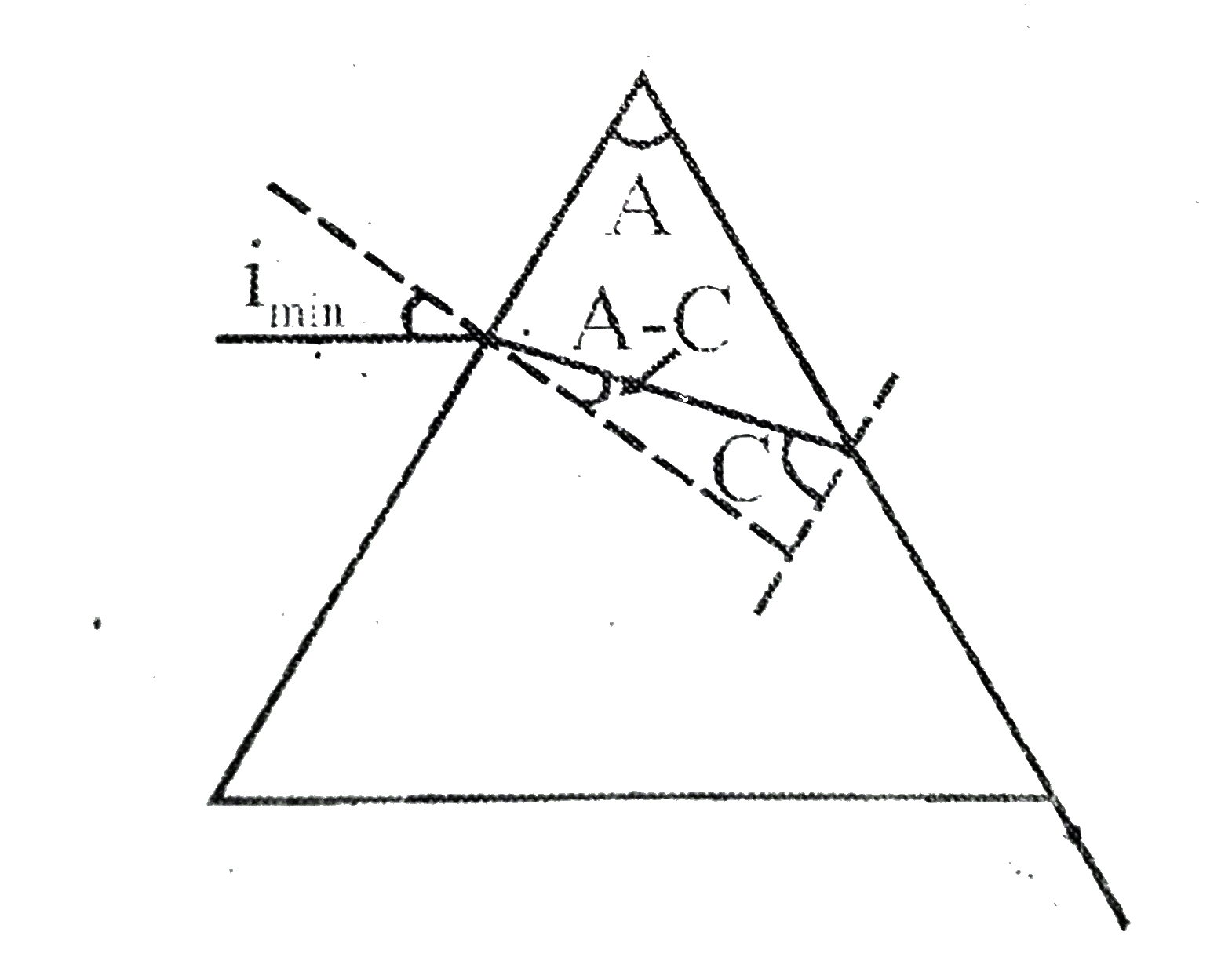For a prism, A=60∘,n=√7/3 . Find the minimum possible angle of incidence, so that the light ray is refracted from the second surface. Also, find δmax. Solution in Gujrati
30∘
45∘
60∘
90∘
The correct Answer is:A
In minimum incidence case the angles will be as shown in figure.

Applying snell's law :
1×sinimin=√73sin(A−C)
√73(sinAcosC−cosAsinC)
=√73(sin60√1−37−cos60√37)=12
∴imin=30∘
Topper's Solved these Questions
Similar Questions
Find dydx for the following :
(i) y=x7/2 (ii) y=x−3
(iii)y=x (iv) y=x5+x3+4x1/2+7
(v) y=5x4+6x3/2+9x (vi) y=ax2+bx+C
(Vii)y=3x^(5)-3x-1/x
View SolutionFor a prism, A=60^(@), n=sqrt(7//3) . Find the minimum possible angle of incidence, so that the light ray is refracted from the second surface. Also, find delta_(max) .
View SolutionRefractive index of a prism is sqrt(7//3) and the angle of prism is 60^(@) . The minimum angle of incidence of a ray that will be transmitted through the prism is
View SolutionA prism of refractive index √2 has refractive angle 60∘ . Find the angle of incidence so that a ray minimum deviation.
View Solutionअपवर्तक कोण 30∘ वाले प्रिज्म के एक पृष्ठ पर प्रकाश किरण कोण 60∘ पर आपतित होती है | प्रिज्म से निर्गत किरण आपतित किरणे के साथ कोण 30∘ बनाती है | प्रिज्म के पदार्थ का अपवर्तनांक भी ज्ञात कीजिए |
View SolutionA ray of light is incident on one face of a prism ( m= sqrt(3) ) at an angle of 60^@ . The refracting angle of the prism is also 60^@ . Find the angle of emergence .
View SolutionThe refracting angle of a prism is 60^(@) and its refractive index is sqrt((7)/(3) . What should be the minimum angle of incidence on the first refracting surface so that the ray can emerge somehow from the second refracting surface?
View SolutionThe refracting angle of a prism is 60^(@) and the refractive index of its material is sqrt((7)/(3)). Find the minimum angle of incidence of a ray of light falling on one refracting face of the prism such that the emerging ray will graze the other refracting face.
View SolutionThe angle of incidence for a ray of light at a refracting surface of a prism is 45^(@) . The angle of prism is 60^(@) . If the ray surface minimum deviation through the prism, the angle of minimum deviation and refractive index of the material of the prism respectively, are:
View Solution50∘ के कोण पर आपतित प्रकाश की किरण, प्रिज्म में से न्यूनतम विचलन से अपवर्तित होती हैं। प्रिज्म का कोण 60∘ हैं। न्यूनतम विचलन का कोण और प्रिज्म का अपवर्तनांक निकालें।
View SolutionThe value of the refractive angle of a prism 60^@ And the refractive index of its components sqrt (7/3) . Find the minimum value of the angle of incidence of a ray of incident on one of the refractory surfaces of the prism.
View SolutionRefractive index of a prism is √7/3 and the angle of prism is 60∘. The minimum angle of incidence of a ray that will be transmitted through the prism is
View SolutionFor a prism, A=60^(@), n=sqrt(7//3) . Find the minimum possible angle of incidence, so that the light ray is refracted from the second surface. Also, find delta_(max) .
View SolutionA ray of light is incident on one face of a prism ( m= sqrt(3) ) at an angle of 60^@ . The refracting angle of the prism is also 60^@ . Find the angle of emergence .
View Solutionप्रिज्मा के किसी अपवर्तक पृष्ठ पर किसी प्रकाश की किरण के लिए आपतन फणा का मान 45 है। प्रिंज्म कोणा का मान 60 है। यदि यह किरण प्रिज्म से न्यूनतम विचलित होती है, तो न्यूनतम विचलन कोणा तथा प्रिज्मा के पदार्थी का अपवर्तनांक क्रमश: हैं:
View Solution
